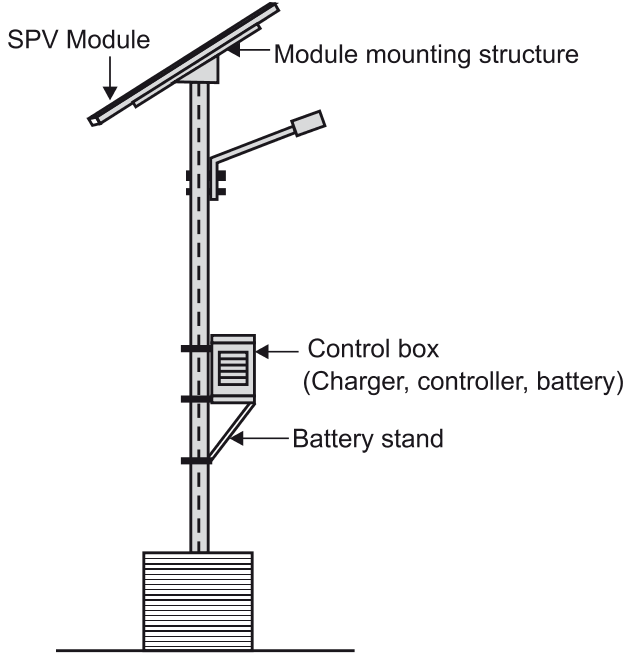A solar street light is a renewable energy-based outdoor lighting system that operates using solar power. It consists of photovoltaic panels (solar panels) that absorb sunlight, convert it into electrical energy, and store it in batteries to power LED or CFL lamps during nighttime. These lights are widely used in streets, highways, parking lots, and remote areas where grid electricity is unavailable.
Components of Solar Street Light

- Solar Photovoltaic (SPV) Module: Converts sunlight into electrical energy.
- Battery: Stores electrical energy for night use.
- Charge Controller: Regulates voltage and current to prevent overcharging or deep discharge of the battery.
- LED Lamp: Provides efficient lighting using stored energy.
- Pole: Supports all components at an optimal height.
- Control Box: Houses the controller, charger, and battery.
- Motion Sensors (optional): Detects movement and optimizes energy usage.
- Mounting Structure: Holds the solar panel at an appropriate angle for maximum sunlight absorption.
Working Principle of Solar Street Lights
- Daytime Charging: The SPV module absorbs sunlight and converts it into DC electricity.
- Energy Storage: The generated electricity is stored in the battery via a charge controller.
- Automatic Operation: The charge controller detects darkness and switches on the light.
- Nighttime Lighting: The battery supplies power to the LED lamp, illuminating the area.
- Motion-Based Optimization (if applicable): Lights operate at reduced brightness and increase intensity when motion is detected.
- Sunrise Detection: The system automatically turns off the light at dawn and resumes charging.
Types of Solar Street Lights
| Type | Description |
|---|---|
| Standalone Solar Street Lights | Independent units with built-in battery storage. |
| Grid-Connected Solar Street Lights | Connected to the power grid for backup. |
| All-in-One Solar Street Lights | Compact system integrating panel, battery, and LED lamp. |
| Hybrid Solar Street Lights | Uses both solar energy and conventional electricity. |
| Motion Sensor-Based Solar Street Lights | Energy-efficient with motion detection for optimized lighting. |
Advantages of Solar Street Lights
- Eco-Friendly: Uses renewable solar energy, reducing carbon footprint.
- Cost-Effective: Eliminates electricity bills and reduces maintenance costs.
- Independent System: Works even in remote or off-grid locations.
- Low Maintenance: Long-lasting LED bulbs and durable batteries reduce upkeep efforts.
- Automatic Operation: Smart controllers enable dusk-to-dawn functionality.
- Enhanced Safety: Provides lighting in areas without grid power, reducing accidents and crime rates.
Disadvantages of Solar Street Lights
- High Initial Cost: Installation cost is higher than conventional street lights.
- Weather Dependent: Performance drops on cloudy and rainy days.
- Battery Degradation: Batteries require periodic replacement after a few years.
- Theft and Vandalism: Components, especially batteries and panels, are prone to theft.
- Space Requirement: Panels need adequate space and proper positioning for optimal performance.
Applications of Solar Street Lights
- Urban and Rural Roads: Provides efficient lighting for pedestrian and vehicle movement.
- Highways and Expressways: Enhances visibility and reduces accidents.
- Residential Areas: Used in gated communities, parks, and driveways.
- Parking Lots: Ensures safety in commercial and industrial parking areas.
- Public Places: Parks, stadiums, and event spaces benefit from solar lighting.
- Remote and Disaster-Prone Areas: Provides reliable lighting where grid power is unavailable or unreliable.
- Security and Surveillance: Used in CCTV-integrated street lighting for enhanced security.
Conclusion
Solar street lights are a sustainable and energy-efficient lighting solution that plays a crucial role in modern infrastructure. They help in reducing dependency on conventional energy sources, lowering operational costs, and improving public safety. Despite some challenges, ongoing advancements in battery technology and smart control systems are making solar street lighting more reliable and cost-effective for widespread adoption.